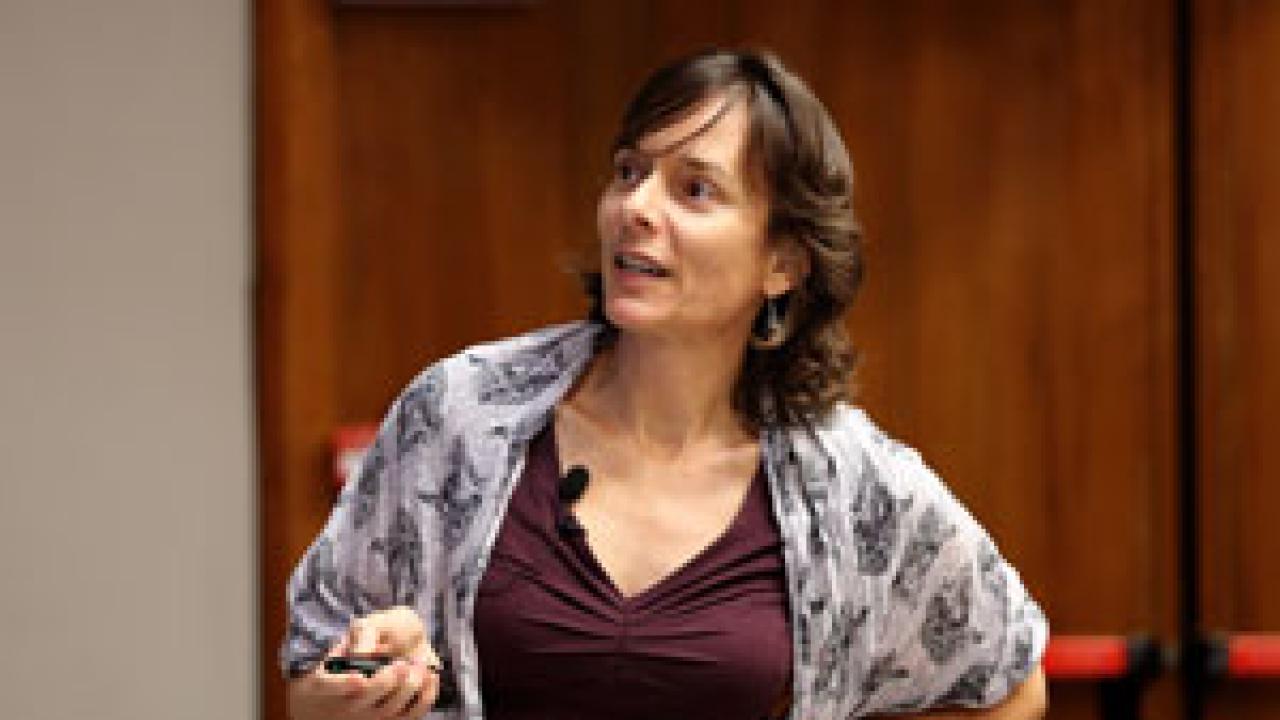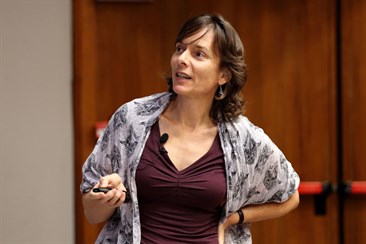
It was an observation casually made at a coffee break by another postdoctoral fellow that led to a driving question for Dr. Nicola Spaldin’s career. Spaldin had just moved to a lab where the principle investigator specialized in so-called ferroelectric materials, which are insulating materials containing electric dipoles, pairs of equal but opposite charges. Spaldin herself specialized in ferromagnetic materials, familiar to us for example as common magnets. A colleague commented while drinking coffee one day, Spaldin remembers: it’s a pity there are no ferroelectric magnets!
 “That question of why there are no magnetic ferroelectrics basically became an obsession for me,” Spaldin says. “I started to investigate why the electrons want to be either one or the other, and that’s led to many of my current research directions.” That spawned a quest through solid state chemistry, Spaldin’s background, and its continuum with materials science and applied physics. After investigating why there were no ferroelectric magnets, she designed a new class of materials called multiferroics, which are materials that are simultaneously ferroelectric and ferromagnetic, tricking the electrons into doing both.
“That question of why there are no magnetic ferroelectrics basically became an obsession for me,” Spaldin says. “I started to investigate why the electrons want to be either one or the other, and that’s led to many of my current research directions.” That spawned a quest through solid state chemistry, Spaldin’s background, and its continuum with materials science and applied physics. After investigating why there were no ferroelectric magnets, she designed a new class of materials called multiferroics, which are materials that are simultaneously ferroelectric and ferromagnetic, tricking the electrons into doing both.
Spaldin was recently at ICTP to give an ICTP Colloquium for all scientists on one of the lines of research that has branched out of that original question. “Most of the questions that interest me are interdisciplinary ones: how can we take skills and tools from one field and move them across to another?” Spaldin says. She’s interested in whether multiferroics might have a role to play in the quest for superconductors, but it’s not just boundary regions between fields that she works in. “From Materials to Cosmology: studying the early universe under the microscope” was the title of her Colloquium at ICTP, covering new ways to dissect what could have happened in the first instants after the Big Bang. Spaldin’s lab created a multiferroic material with magnetic, electric, and structural phase transitions that mathematically mimic cosmic strings. With this multiferroic, materials scientists cosmologists can collaborate on experiments that they can’t do on the universe itself.
Spaldin was also at ICTP to attend and speak at the Career Development for Women in Physics workshop, which she co-organized and partially financed. As a 2017 winner of the L’Oreal-UNESCO Prize for Outstanding Women in Science, Spaldin gave part of her award funds to make it possible for scientists from all over the world, especially from developing countries, to travel to Trieste for the workshop. “After this workshop, I hope that the participants end up more able to fulfill their potential as scientists, with more skills, so they’re not as hindered by non-scientific obstacles,” says Spaldin.
Women in science still face a lot of sexism and discrimination from men in science, in addition to many other societal factors that add up to only 28% scientists globally are female. Implicit or unconscious bias, besides active discrimination, has something to do with this number being so low, Spaldin says. “Unconscious bias is very difficult to quantify and hard to address,” says Spaldin. “Very well-meaning people often don’t realize they have it, and we all have it.” The societal perception of what a scientist looks like and what a scientist is generally does not include being short and female, Spaldin says. “People don’t expect a scientist to behave and look like I do.”
The workshop was, for Spaldin, an opportunity, “and a privilege to meet some very talented scientists from all over the world. They have different approaches and ideas, coming from different scientific backgrounds and cultures.” That mix of people is something that Spaldin consciously cultivates in her own lab at ETH Zurich. Scientists coming to her lab “have to be nice, of course, and have different backgrounds to my own. Otherwise there would not be much for us to learn from each other.” She moved her lab to ETH, where she is a professor of materials theory, in 2011, and “it’s paradise. We’re spoiled in terms of resources and staff support, and respect from society. There’s a sense in Switzerland that we would be less well off without banking and precision engineering, so education is respected. It’s a unique place.”
That paradise means Spaldin can always explore the next question. Right now she’s interested in multiferroic quantum criticality, which, despite sounding like a science fiction invention, is proving very interesting. A quantum critical point is when a material goes through a continuous phase transition (as in transitioning between a solid and a liquid) at 0 degrees Kelvin, absolute zero. Ferroelectrics and ferromagnetics both have quantum critical points, and those continuous phase transitions can have superconducting powers. Now with multiferroics, Spaldin’s question is “Can you make a material with both quantum critical points? Can you sort of tune them by applying pressure and bring them together—what could it do? The electrons are so confused at this point, it’s esoteric behavior.” The hope, the potential, is for a superconductor that can work at room temperature.
“I have the most fun doing science that is interesting and difficult,” Spaldin says. The work she does is very fundamental, but it’s not far fetched. “I enjoy knowing that it has potential medium-term applications.” One day soon, the newest inventive devices might be made out of materials designed thanks to Spaldin’s work.
----- Kelsey Calhoun
















